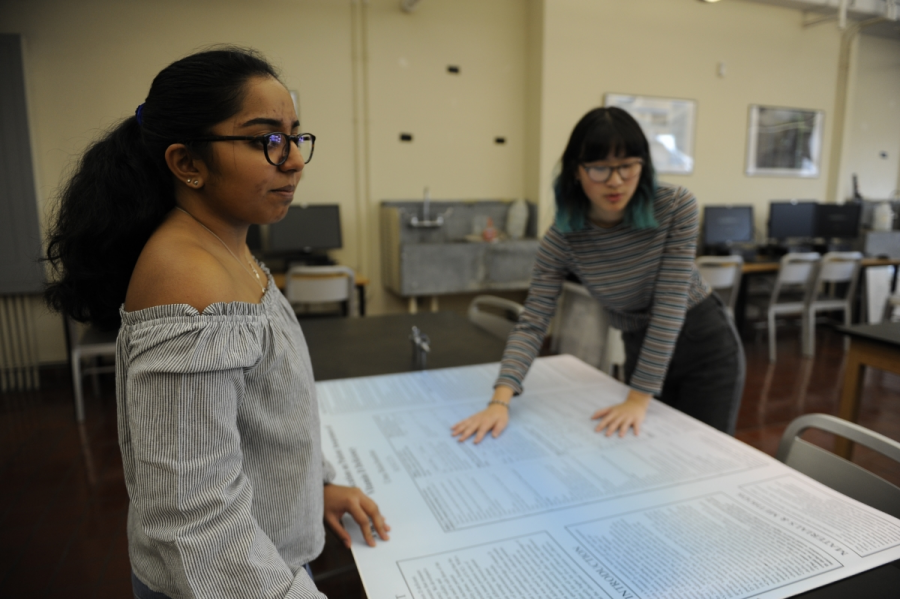Science Research Seniors: Profiles in Dedication
Uma Balachandran ’18 and Alexandria Ang ’18 work on poster presentations for their Senior Research Poster Session.
Nothing shows true commitment like participating in the school’s research program. Introduced to them in their sophomore year, this three year course is available for those who have an interest in research and want to develop their own projects with a mentor. Although this is a course taken in school, most of the work is done outside of Bronx Science. Whether it’s commuting to and from their research institution or spending multiple hours analyzing data from their experiments, these students often lead busy lives.
Over a hundred students in each class pursue the program for its full three years. One of these students is Uma Balachandran ’18, who is planning on pursuing a career in medicine. Her long-standing interest in orthopedic surgery, in addition to her fascination with the practicality of the field, led her to continue researching at a hospital in hopes of gaining a greater understanding of her future occupation.
Her project, entitled, “The Effect of Education on Patient Awareness of Vitamin D Deficiency,” aims to raise awareness of vitamin D deficiency and compliance rates with vitamin D supplementation.
“I think the most rewarding part were the experiences that I gained along the way,” said Balachandran. “Getting to spend that much time in the best orthopedic hospital in the country, alongside some of the most distinguished people in the field is a once in a lifetime experience.” In the future, she plans on expanding her studies and conducting more clinical research.
Other research students, such as Maxwell Allison ’18, also continued research in order to explore his career interests. “I had always been interested in science and biology, but the only way that I thought that I could pursue science was by becoming a doctor,” he said. “Everyone in my lab is very determined and devoted to their research, and they inadvertently convinced me to pursue research as my career.”
Allison has already spent three years studying the production of stable T-cell lines with overexpression and deletion of P2X1 and P2X7 purinergic receptors. His work involved creating competent cell lines and using CRISPR technology to delete genes for purinergic receptors. Through the use of cloning and other genetic techniques, he was able to create the cells needed to study HIV infection. Although he personally plans to discontinue this study after the research program, the cell lines that he created will be infected and analyzed by his lab to further study the interactions between purinergic receptors and HIV infection.
“Getting to spend that much time in the best orthopedic hospital in the country, alongside some of the most distinguished people in the field is a once in a lifetime experience.”
On the other hand, others do hope to continue the work they’ve begun in Intel. By researching tumor cells and discovering a novel therapeutic targets (ERβ2 and ERβ1), Nicole Wang ’18 was able to learn of new ways to enhance ionizing radiation therapy. When asked about future plans, she reveals a decision that she had made by her third year in the program.
“I want to continue my research in the future and hope to start a clinical trial,” Wang said. “I will be designing a lentiviral and nanoparticle based delivery systems to reintroduce ERβ1 into prostate cancer cells in Vivo using mouse models.”
No matter what their research entails, these accomplished individuals are dedicated to their work. It is no doubt that the hard work they put into their final research projects will be greatly beneficial to them as they pursue their future careers in the hard sciences, mathematics, and social sciences.
Samira Ashif, a senior in her third year of Journalism, is a Staff Reporter for ‘The Science Survey’ and a People Section editor for ‘The Observatory.’...

